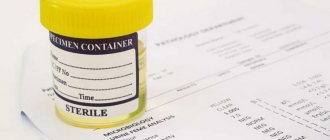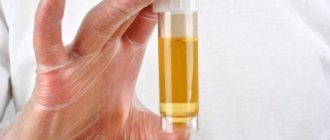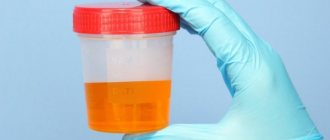About the study
Based on the results of urine biochemistry, disturbances in the functioning of the kidneys, ureters, bladder, liver, and parathyroid glands are determined. This laboratory analysis is highly informative and reliable. For a comprehensive examination, two types of BAM are used:
- Analysis of a single portion of urine - laboratory testing of morning urine. It determines the level of glucose, bilirubin, pancreatic amylase, alpha-amylase. If the indicators deviate significantly from normal values, the person is referred for further examination. An increased glucose level indicates diabetes, and bilirubin indicates inflammation of the bile ducts or liver.
- Daily urine analysis is a laboratory test of urine excreted during the day. Detects malfunctions in the functioning of the urinary system. In a daily portion of biomaterial, the concentration of creatinine, albumin, urea, and calcium is determined. The study is carried out to monitor the effectiveness of treatment of pyelonephritis, diabetes mellitus, glomerulonephritis. It is prescribed during pregnancy for the timely detection of abnormalities in fetal development.
Biochemical examination of urine allows one to assess the performance of vital organs without biopsy or surgery. To obtain objective results, prepare for the fluid collection procedure in advance.
When diagnosing urological diseases, they often resort to 24-hour urine biochemistry. This analysis provides the most accurate picture of your health status.
The results of a 24-hour urine test make it possible to determine the presence of a number of abnormalities and diseases. With its help, the total volume of fluid released, the presence of sugar and salts in it are assessed. Protein concentration is also measured, the amount of which is a serious indicator for diagnosis. To do this, within 24 hours the patient collects urine in a special large container, which he keeps in the refrigerator until the end of the analysis.
Indications for analysis are the following diseases and abnormalities:
- an increase in albumin during a routine urine test;
- jades;
- diabetic kidney damage;
- hypertension;
- gestosis in pregnant women;
- tubulopathy of hereditary origin;
- kidney amyloidosis;
- systemic diseases;
- fever;
- multiple myeloma;
- severe infections;
- heavy metal poisoning;
- taking nephrotoxic drugs.
It is quite difficult to establish the correct diagnosis based only on deciphering the protein levels of daily urine and symptoms. If there is an increased protein content in the urine, it is recommended to carry out the following tests to clarify the pathology:
- Determination of the ratio of protein and creatinine in the morning portion. This will help identify kidney problems. The measurement result often helps to identify nephron pathology against the background of non-insulin-dependent diabetes. The normal rate for children over 2 years of age and adults is 0.2 and below.
- Blood biochemistry to determine the level of albumin, glucose, proteins, urea and creatine. Helps clarify renal dysfunction and the presence of other diseases associated with proteinuria.
- Glomerular filtration rate or the amount of blood passed through the kidneys per unit time. Normally it is from 110 to 125 ml/min. Allows you to clarify the presence of chronic and acute inflammatory diseases (nephritis), as well as suspect hypertension, diabetes and systemic pathology.
- Ultrasound of the kidneys. Helps determine the presence of stones, tumors and cystic formations.
To make a clinical diagnosis, it is sometimes necessary to consult a physician, nephrologist, urologist, cardiologist and other specialists if necessary. In pregnant women, if elevated protein is detected in the urine, a full examination in a hospital will be required to prevent fatal consequences for the mother and the unborn child.
Reasons for the appearance of protein in the urine of an adult
It is necessary first of all to determine why the protein in the urine has increased and the reasons. The norm of daily urine allows for a small amount of protein. If the indicator does not correspond to the established value, then this signals a possible pathology. A high concentration of protein in the urine is a consequence of the following diseases:
- kidney tuberculosis;
- pyelonephritis;
- nephropathy;
- metabolic disease;
- hypertension;
- urinary tract infections.
Typically, kidney diseases are characterized by the appearance of other specific symptoms. In some cases, there is an increase in temperature, chills, and pain in the lumbar region. If no action is taken at this stage, the disease begins to progress, dizziness and nausea appear, which can result in vomiting. In the future, in the absence of proper treatment, the structural elements of the body begin to collapse.
How to properly collect daily urine for analysis
Biochemical urine analysis (BAM) is an informative diagnostic study that determines the functional state of the urinary, hepatobiliary, and endocrine systems. Prescribed for:
- preventive examination;
- control of diuretic treatment;
- diagnosis of diseases of the genitourinary system;
- management of pregnancy;
- suspicion of hidden inflammation in the body.
The results of the analysis are interpreted by doctors of different specializations. The BAM data is deciphered most accurately by a therapist, urologist, nephrologist, obstetrician-gynecologist, pediatrician.
At the initial appointment, the doctor tells the patient how to submit daily urine for analysis. Proper preparation and collection of biomaterial prevents false-positive or false-negative results. Preparations begin 2 days before going to the clinic.
Rules for preparing for biochemical analysis:
- 2 days before urine collection, stop taking medications;
- fatty foods and alcohol are excluded from the diet;
- limit physical and psycho-emotional stress;
- refuse to visit the solarium and bathhouse;
- collection of biomaterial is carried out before endourethral procedures (ultrasound, catheterization, smear);
- maintain normal drinking regime;
- exclude foods that stain urine (carrots, beets, wild berries).
When planning an examination, you must tell your doctor what medications you take regularly or have taken within the last month. Biochemistry results are influenced by:
- metronidazole;
- herbal remedies with bearberry;
- loop diuretics;
- sulfonamides;
- hormonal contraceptives;
- aspirin;
- sulfazole;
- vitamin and mineral complexes.
If a daily urine sample is used for analysis, any travel on that day should be postponed. A change in environment and diet will lead to changes in the biochemical composition of urine, which will affect the test results.
Rules for collecting daily urine:
- Container for biomaterial. To collect liquid, use sterile plastic containers with airtight lids. Their volume must be at least 2.5 liters.
- Recording the time of fluid collection. Urine is collected 24 hours in advance. If the first portion was collected at 8-00 in the morning, then the last portion is collected at the same time the next day.
- Hygiene procedures. Before collecting urine, the genitals are washed with neutral soap.
- Collection of liquid. You should urinate in a dry and sterile small container. The container should not touch the skin, as this will cause epidermal cells to enter the liquid. A single portion is poured into a large container with a volume of 2.5-3 liters, closed with a lid and sent to the refrigerator.
When collecting 24-hour urine, the morning portion of the first day (immediately after you wake up) is not collected.
The container with biomaterial is stored on the bottom shelf of the refrigerator to prevent sedimentation. On the day of the test, the urine is shaken in a common container. No more than 200 ml of liquid is poured into a separate container with a sealed lid and sent to the laboratory.
93-97% of urine consists of water. The remaining part comes from metabolic products - organic and inorganic substances. By assessing the composition and quantitative indicators of individual components, urological and endocrine diseases are diagnosed.
Urine enzymes
During a daily urine test, a large number of enzymes are determined. For diagnosis, the following are important:
- Amylase is an enzyme that is synthesized in the pancreas and salivary glands. Normal values are in the range of 1-17 U/l. Deviations indicate acute pancreatitis, cholecystitis, intestinal obstruction, relapses of sluggish pancreatitis. Changes in amylase levels occur against the background of stomach ulcers and alcohol intoxication.
- Gamma-glutamate transpeptidase is an enzyme that is involved in the oxidation and synthesis of amino acids. Normal (reference) values are in the range of 48-49 U/mmol CRE. An increased concentration of lactate dehydrogenase in the urine indicates liver pathology - viral hepatitis, hepacellular carcinoma, cirrhosis. Increased enzyme activity is detected in patients with diabetes mellitus, pancreatitis, mononucleosis and prostate cancer.
- Lactate dehydrogenase is an enzyme that is involved in the synthesis of lactic acid and the breakdown of glucose. Normally, its content in urine does not exceed 8300 units/8 hours. Deviations indicate inflammation and necrosis of the liver, lungs, skeletal muscles, kidneys, and heart.
To clarify the diagnosis, it is necessary to take into account the analysis data for the content of urea and creatinine in the urine.
In the absence of disease, protein is not detected in the urine. If protein components are detected during the analysis, this indicates a violation of the kidney filtration function, proteinuria. Its reasons include:
- multiple myeloma;
- hypertension;
- cystitis;
- urethritis;
- pyelonephritis;
- ureteral tumors;
- systemic lupus erythematosus;
- heart failure.
At rest, reference protein values do not exceed 0.08 g/day, and during intense exercise – 0.25 g/day.
Amino acids
When diagnosing urological diseases, the concentration of amino acids is of diagnostic importance. In a daily portion of urine in children and adults, their amount should not exceed 50-200 mg.
| Amino acid name | Causes of high levels in urine |
| tyrosine | ascorbic acid deficiency |
| tryptophan | deficiency of pyridoxine (vitamin B6) |
| serine | cadmium intoxication |
| hydroxyproline | pathology of bone tissue |
| leucine, cysteine | poisoning with oxalic or malic acid |
If the test results differ from normal values, this indicates a vitamin deficiency, metabolic disorder or the mechanism of reabsorption of amino acids in the kidneys.
Glucose
In a daily urine test, the glucose concentration is 2.5-2.78 mol/l. If its content exceeds the norm by 10 times, glucosuria is diagnosed. It accompanies many diseases:
- diabetes;
- hyperthyroidism;
- phosphorus intoxication;
- Cushing's syndrome;
- myocardial infarction;
- dumping syndrome;
- pancreatitis.
The results of the analysis are affected by taking medications - thyroxine, diuretics, corticosteroids, carbamazepine.
Nitrogenous substances
| Age, years | Nitrites, mol/day | Urea, mol/day | Ketone bodies, mmol/day | Uric acid, mol/day | Creatinine, µmol/kg |
| up to a year | — | 10-100 | less than 0.5 | 0.3-2.0 | 71-176 |
| 1-8 | — | 50-250 | less than 0.5 | 0.5-2.51 | 71-195 |
| 9-14 | — | 200-430 | less than 0.5 | 0.61-3.0 | 71-264 |
| from 15 | — | 400-710 | less than 0.5 | 1.47-4.4 | 97-230 |
Exceeding the normal levels of nitrogenous substances in the urine is a consequence of metabolic failures and impaired filtration function of the kidneys.
Bile pigments
During the analysis, two types of bile pigments are determined:
- Bilirubin is one of the main components of liver secretion. Normally it is not detected in urine. Increased activity of the pigment is associated with liver pathologies - cirrhosis, hepatitis, liver cancer, jaundice.
- Urobilinogen is a pigment produced in the liver from hemoglobin. Its content in urine should remain in the range of 0-35 µmol/l. An excess indicates toxic liver damage, enterocolitis, massive hematomas, and intestinal obstruction.
Increased activity of bile pigments is an indication for contacting a hepatologist. You will need to take a biochemical blood test.
Hemoglobin
Urine biochemistry normally does not reveal hemoglobin. It is found during the intrarenal or intravascular breakdown of red blood cells (erythrocytes). Hemoglobin impurities in urine indicate:
- intoxication with sulfonamides;
- general blood poisoning;
- hemolytic anemia.
Iron-containing protein penetrates into the urine in deep and extensive burns.
Microelements
The concentration of important microelements in urine is of diagnostic importance:
- Calcium – participates in the synthesis of bone tissue. The daily norm of the microelement in urine does not exceed 7.5 mmol. An excess indicates overactivity of the parathyroid glands, decreased kidney function, and osteoporosis.
- Potassium – participates in water-salt metabolism, affects the performance of skeletal muscles and the nervous system. In urine its content does not exceed 100 mmol/day. Excess potassium is associated with inflammatory kidney damage, blood transfusions, and serious injuries.
- Sodium – affects the synthesis of gastric juice, enzymes in the gastrointestinal tract, and vascular tone. Reference values for biochemical analysis of urine are 130-260 mmol/day. Deviations indicate a violation of the acid-base balance, kidney dysfunction, and diabetes mellitus.
- Phosphorus – participates in lipid and protein metabolism. The daily norm does not exceed 40 mmol. If during analysis the level of phosphorus in the urine is elevated, this indicates urate kidney stones or leukemia - blood cancer.
When interpreting the results of urine biochemistry, data from other tests and instrumental diagnostics are taken into account.
I’ll say right away that a woman should give urine every time before a scheduled visit to the doctor.
Here the delivery frequency is as follows:
- up to 20 weeks of pregnancy – once a month;
- from 21 to 27 weeks - once every two weeks;
- from 27 weeks - every week.
When the result satisfies the specialist and the woman has no complaints, no additional measures are taken. If the result is alarming or not satisfactory, a biochemical analysis of 24-hour urine is performed. As the name of the event says, it takes place over the course of 24 hours. What is it prescribed for?
Samples can be of several types:
- for daily diuresis, relevant for edema, this way you can determine how much fluid remains in a woman’s body;
- glucosuric profile, also called a daily urine test, which is tested for sugar;
- on the biochemical parameter of total protein, thus assessing the work of internal organs.
People often ask why 24-hour urine is required, is it possible to establish pathology using a routine analysis? No! A thorough study makes it possible to determine not only the specific gravity, but also the ratio of the components. And this is important for determining pathology.
Collecting a specific urine sample according to Nechiporenko
There are no great difficulties in correctly collecting and submitting a sample of biological fluid for research. However, as a result of neglecting the basic rules, you can obtain false final analysis data. Before donating urine, a woman needs to prepare a sterile container with a tight lid that will prevent pathogens from entering the sample.
This is what a container recommended for collecting urine looks like; it can be purchased at a pharmacy chain; if this is not possible, a sample of biological fluid is collected in any glass container treated with freshly boiled water
For a urine test to be reliable, a pregnant woman must: 24 hours before collecting biomaterial:
- refrain from all activities that require excessive physical stress - this can provoke an increase in the level of protein in urine;
- limit the amount of consumption of meat products, spicy, sour, salty foods;
- Avoid taking medications.
On the eve of the study, the expectant mother should not eat foods that can change the color of urine - beets, spinach, carrots, rhubarb, tomatoes, pumpkin, citrus fruits.
Urine collection is carried out immediately after waking up in the morning - the study requires a portion of the biological fluid that has accumulated overnight. The peculiarity of the functional activity of the kidneys at night allows us to obtain a more concentrated sample for testing, in which deviations of all parameters from the norm can be clearly determined.
Before filling the container, a woman should thoroughly wash her external genitalia. Failure to comply with this rule can lead to the ingress of a large number of leukocytes, epithelium and erythrocytes into the biomaterial sample, which will entail the diagnosis of “false” pathological processes. For the toilet, a soap solution or a weak solution of manganese is suitable, which is washed off with plenty of warm boiled water.
We invite you to read: How to properly use Magnelis B6 during pregnancy, video and reviews
To conduct this study, about 30 ml of an average portion of biological fluid is sufficient. The test is prescribed if a pregnant woman is suspected of having kidney diseases such as pyelonephritis and glomerulonephritis.
Hygiene of the external genitalia must be carried out with special care before submitting a sample for testing. You should wash yourself without using antibacterial agents; if you use soap, you should rinse it off with plenty of warm boiled water and wipe dry with a clean towel. Body fluid is collected in the middle of urination.
The resulting biomaterial sample must be delivered to the laboratory center as soon as possible.
Causes of proteinuria
The detection of protein in the urine is not always a sign of disease of the kidneys or other organs; often, the transient phenomenon of proteinuria occurs in some physiological conditions. Increased protein secretion by the glomeruli of the kidneys within normal limits is observed during the daytime, with active movement, in an upright position.
Normally, only minor traces of the protein may be detected in healthy people. When urine is formed, the blood passes through the tubules of the kidneys, while conventional filters do not allow the protein to pass through due to its high molecular weight. Albumin is partially released into the primary urine, but is then reabsorbed back.
Physiological
The absence of pathology and the simultaneous appearance of protein in the urine occurs quite often; at a level of up to 0.033 g/l, the question of the disease is not raised. But if there are other signs, the doctor prescribes a repeat test. Physiological proteinuria occurs in the following cases:
- stressful situations;
- hypothermia;
- physical exercise;
- fever;
- burn;
- overheating in the sun;
- conducting active palpation of the lower abdomen and kidney area;
- treatment with certain medications.
Pathological
Violation of protein production in the body, a problem with its reabsorption, and its release from damaged tissues leads to proteinuria. A urine test for protein shows its high content in the following cases:
- nephropathy;
- pyelo- or glomerulonephritis;
- kidney stones;
- inflammation of any organ of the urinary system;
- infectious diseases;
- tuberculosis or kidney injury;
- chemotherapy;
- metabolic disorders;
- leukemia;
- brain damage due to traumatic brain injury;
- cardiovascular failure;
- gangrene of the limb;
- cancer tumor.
Causes of protein in urine
The most common kidney disease during pregnancy is gestosis, which is an extremely dangerous pathology. The disease is characterized by severe swelling of the tissues, accompanied by hypertension, dizziness and severe weakness. Most often, women in the second trimester of pregnancy are susceptible to gestosis. Other infectious kidney diseases that develop during pregnancy include pyelonephritis and glomerulonephritis. The disease progresses when protein is observed in the urine, the norm of which should not be exceeded. At the initial appointment with a doctor for suspected pyelonephritis, a pregnant woman complains of characteristic pain in the lumbar region and bladder. With glomerulonephritis, a specific red color of urine is observed. Laboratory tests reveal the presence of increased levels of leukocytes and red blood cells in the urine.
What the analysis shows
Urine is a biological fluid, the composition of which depends on the correct functioning of the kidneys, liver, and endocrine system organs. Based on the results of biochemical analysis, the following are diagnosed:
- urolithiasis (urolithiasis);
- pyelonephritis;
- kidney failure;
- glomerulonephritis;
- nephrolithiasis;
- toxicosis of pregnant women;
- dehydration;
- diabetes;
- electrolyte imbalance;
- liver pathologies;
- hyperfunction of the parathyroid glands.
In urine biochemistry, more than 30 different indicators are determined.
Depending on the symptoms, the doctor prescribes the study of only individual organic and inorganic substances. A 24-hour urine test for protein is one of the most informative procedures for determining kidney dysfunction. The advantage of the study is the ease of collecting material and the ability to quickly find out the result.
A urine test shows whether there are foci of inflammation, infectious processes, and how well the kidneys cope with the filtration function.
To get a reliable result, you need to properly prepare and collect material.
Determination of protein in urine using a daily analysis is carried out if proteinuria was shown by a preliminary general analysis. The kidneys filter the blood, and waste products are excreted along with urine. If the function of the paired organ is impaired, the filtration process is less efficient and proteins enter the urine.
In diabetes mellitus and hypertension, protein in daily urine is one of the markers of severe disorders. As the pathology progresses, the amount of proteins increases.
Externally, a failure of renal function is manifested by swelling, attacks of nausea, shortness of breath, and constant fatigue.
Temporary (passing) proteinuria occurs after heavy physical work and intense training. The reason for the appearance of protein in a daily urine test can be a high temperature during viral, bacterial infections, or during pyelonephritis. If these diseases are suspected, a test of urine collected per day is prescribed.
If 24-hour urine collection is scheduled, you should stop taking diuretics 1-2 days before it begins. Spicy and sour foods are excluded from the diet, and do not drink alcohol. You should stay at home during the urine collection period.
You need to prepare a container for liquid. This can be a 3 liter container purchased at a pharmacy or a bottle of the same capacity. The jar should be washed, doused with boiling water, and allowed to dry.
The doctor who prescribes the test tells you how to properly collect daily urine for protein. He also issues a form with the patient’s data and the name of the study. The paper will need to be provided to the laboratory along with the material. The doctor should clarify whether it is necessary to collect the first portion of urine in the morning, immediately after waking up.
Collection of biomaterial begins at 7 am. Before each emptying of the bladder, it is necessary to thoroughly rinse the external genitalia and dry them with a paper towel. To prevent vaginal discharge from getting into urine, women should cover the external opening of the vagina with a tampon or cotton ball.
During the day, urine is collected every time you visit the toilet. It is convenient to use a small clean container for a new portion, and then pour it into one large container. Keep it tightly closed in a cool place. It is best to use a refrigerator - the storage temperature should not exceed 8 degrees Celsius.
The last portion of urine is obtained at 7 am the next day. All collected liquid is thoroughly mixed, 100-150 ml of urine is poured into a pharmaceutical container.
Before submitting the daily analysis to the laboratory, the total volume of collected material is recorded on a form. Then they are taken to the clinic as quickly as possible.
The amount of protein excreted in urine is measured in milligrams (mg). In a healthy adult, 50 to 80 mg of protein enters the urine per day. Proteinuria is indicated by a reading of 130 mg or more.
The loss of daily protein in urine is divided into the following types:
- microalbuminuria (removal of 25-300 mg of proteins);
- mild proteinuria (300-1000 mg);
- moderate severity (1000-3000 mg);
- massive proteinuria (more than 3000 mg).
The normal levels of protein in daily urine are the same for people of all age groups.
The results of the study are deciphered by a therapist or nephrologist/urologist. Depending on the cause of proteinuria, experts divide it into the following types:
- extrarenal - occurs when the urinary tract is damaged, as well as other organs located near the urethra;
- tubular - a sign of a violation of the integrity of the renal tubules in amyloidosis;
- glomerular - a sign of poor blood supply to the kidney, decreased filtration capacity due to glomerulonephritis, poisoning.
Reasons for the increase
Loss of protein in urine is a sign of kidney problems. The degree of proteinuria depends on how damaged the organ is.
Mildly expressed occurs in chronic pyelonephritis. Moderate proteinuria is observed with:
- acute, chronic glomerulonephritis;
- amyloidosis, systemic lupus erythematosus;
- toxic nephropathy;
- kidney damage due to diabetes mellitus, severe heart disease.
A sign of nephrotic syndrome is a pronounced loss of protein per day (more than 4 g).
Increased excretion of protein in the urine is observed in cases of brain damage and oncological processes. Frequent use of nephrotoxin drugs (aminoglycosides, medications with gold, trimethadione, amphotericin, polymyxin) also causes proteinuria.
In pregnant women, an increased level of protein in the urine is observed, even if proteinuria was not detected during a general analysis. This happens against the background of swelling and increased blood pressure. This condition is dangerous for the health of the expectant mother and fetus, so the woman must strictly follow all the doctor’s recommendations.
Proteinuria may be accompanied by leukocytosis. This indicates a urinary tract infection. Blood impurities in the analysis are a symptom of injured kidneys, bladder or urethra. The analysis reveals a large amount of protein with erythrocytes in glomerulonephritis.
Proteinuria occurs after eating a large amount of meat, physical fatigue, or severe stress. After a few days, the concentration of protein in the urine returns to normal, so this form of proteinuria is considered benign.
Doctors consider low protein levels in daily urine to be harmless. This is normal and nothing to worry about.
The analysis may show an unreliable result if discharge from the genital organs is mixed with the urine. For men it is sperm, for women it is secretion from the vagina.
Therefore, doctors recommend that women not take tests during menstruation, and when collecting urine on normal days, close the entrance to the vagina. The entry of stool particles into the liquid also gives a false result.
Do not analyze 24-hour urine for protein immediately after forced diuresis and drinking large amounts of liquid.
The use of certain medications shortly before diagnosis makes the analysis of 24-hour urine for protein biased. These medications include:
- contrast solutions for x-ray diagnostics based on iodine;
- soda solution;
- antibiotics (penicillin group, cephalosporins);
- sulfa drugs;
- para-aminosalicylic acid.
Patients of inpatient departments and clinics take a urine test for albumin free of charge. In private clinics and laboratory centers, the price of analysis differs. The cost of diagnostics ranges from 250 to 500 rubles.
Consequences
First of all, you should pay close attention to your own health and follow the recommendations of your doctor. The main parameters that the diagnostician focuses on during the examination are protein in the urine, the causes, the norm of protein concentration in a healthy person and any deviation from it. Usually, the doctor prescribes a laboratory test during the treatment process in order to determine how effective the prescribed drugs turned out to be. This also helps to establish the reasons that influenced the development of the disease, and to correct treatment if no visible results are observed.
If kidney disease is suspected, the patient is given a referral for diagnostic testing in the laboratory of a medical institution. As a result of screening, protein in the urine is determined. To do this, you need to collect the discharge per day. If the protein concentration in the material exceeds the norm, this may indicate the presence of a deviation in the body. However, other factors that do not indicate disease can also affect an increase in the amount of protein in the urine. This could be hypothermia, prolonged physical activity, or nervous tension. Therefore, in order to clarify the diagnosis, control tests are carried out after 2 weeks.
Diagnostics
Currently, there are several methods for determining protein in urine. The Brandberg-Roberts-Stolnikov technique is considered the simplest. The collected urine is thoroughly mixed, then 5 to 10 ml is placed in a test tube and nitric acid (30% solution) is slowly added. If there is 33 mg of protein per liter in the urine, then after three minutes a whitish ring will form on the surface.
When the white coating is not detected in the last test tube, take the penultimate container and multiply 0.033 by the dilution level. Then daily proteinuria is calculated using the formula – K = (x*V): 1000. In this case, K is the amount of protein in g, x is its amount in 1 liter of urine before dilution in g, and V is the total volume of excreted daily urine. This test has one drawback, since it can only be used to determine the level of albumin.
More accurate studies require the use of modern equipment and are expensive. If necessary, with their help you can obtain not only the volume of protein in the urine, but also calculate the ratio of its fractions.
How to properly collect daily urine for analysis
To obtain a reliable result, you must follow the rules for collecting urine. Every time before emptying the bladder, it is necessary to perform genital hygiene, but without using soap. Women need to provide daily urine during menstruation. During the day you need to refrain from taking vitamins, diuretics and anticoagulants.
Advice! It is important to observe dietary restrictions, reduce the consumption of sweets, hot sauces, and animal fat. Alcohol and coffee should also be avoided.
Urine is collected over 24 hours. You should go to the toilet for the first time at 6 am, but do not take this portion, nighttime diuresis should also be taken into account, the last time the test is taken is the next morning. All collected urine should be mixed and taken to the laboratory. If you need to determine the daily volume of liquid, then you need to hand over all the material.
How to normalize diuresis?
The body of a pregnant woman needs fluid just like the body of any other person. Normally, daily water consumption is 1-2 liters; in case of pregnancy, it may deviate slightly upward or downward.
The following factors influence the amount of fluid you drink per day:
- indoor air temperature and humidity;
- time of year - in summer you want to drink more and more often;
- labor intensity;
- medications taken;
- drinking habits of a person developed over the years.
Normally, at least 70-80% of the volume of fluid taken per day should be excreted in the urine. The remaining 20% is excreted through the sweat glands. It is important to consider the consumption of not only water, soup and tea, but also solid foods. Bread, pastries and chocolate contain a certain percentage of moisture. Ingredients information can be found on the product packaging.
The cause of abnormal diuresis can be determined by a doctor after a complete medical examination of the patient. After the final diagnosis is established, the specialist will prescribe treatment therapy with the possible use of diuretics during pregnancy.
An integrated approach to treatment involves changing the pregnant woman’s lifestyle. To normalize diuresis, you will have to give up overly spicy, sweet and salty foods so as not to experience a regular feeling of thirst. You can use folk recipes for diuretics - a decoction of rosehip or cranberry. In addition to normalizing water balance, they perfectly strengthen the immune system due to the high concentration of vitamin C in their composition.
To regulate diuresis, it is recommended to use multivitamin mineral complexes. Vitamins strengthen the walls of blood vessels, gently remove excess moisture from tissues and organs, and normalize blood circulation.
When do you give urine for biochemistry?
Microelements
Loss of protein in urine with normal function of the kidneys and other organs per day ranges from 40 to 80 mg. When results are taken into account, some deviations may occur. This figure is the same for women and men. A significant pathology is considered to be an albumin level of more than 150 mg in 24 hours.
More precisely, proteinuria is divided into the following groups (g/l/day):
- trace – contains 0.033 or less;
- mild – from 0.1 to 0.3;
- moderate – from 0.3 to 1;
- pronounced (severe) – 3 or more.
It is important to know! The combination of high protein and blood in the urine indicates diffuse or focal damage to the urinary system, and the presence of a large number of leukocytes indicates an infectious disease.
Collection of urine for research using the Zimnitsky method
Urinalysis is one of the important tests during pregnancy, as it allows you to timely identify and prevent many threats.
Unfortunately, not everyone knows how to properly take a urine test in order to get reliable results.
True research indicators are necessary for the attending physician, otherwise he cannot guarantee the preservation of the full health of the woman and child during pregnancy.
To avoid distortion of the research results, you must follow simple rules:
- A day or two before the test, do not engage in any physical activity or overexert yourself. Otherwise, the test result may show a large number of protein components in the urine. And this is a deviation from the norm.
- Avoid salty, spicy, fatty foods, as well as meat dishes two days before donating urine.
- The container for collecting liquid must be sterile. Basically, patients buy containers for collecting urine at the pharmacy, however, you can use a regular jar, as long as it is dry and clean.
- The most informative analysis is obtained by taking morning urine. At night, the kidneys function in a special mode. You may notice that morning urine is strikingly different in color from daytime urine, because it has a darker and more saturated hue due to the high concentration of liquid. It is better to collect urine immediately after waking up.
- It is important to follow all hygiene rules; before collecting the analysis, disinfect the external genitalia with water and soap.
- Many women use a cotton swab to eliminate the possibility of vaginal discharge. If you decide to take a shower in the morning, you don’t need to perform this procedure.
- In order for the study to be as informative and accurate as possible, collect an “average” portion of urine. For the first 3 seconds, urinate into the toilet, for the next 3 seconds, collect the urine in a container, and the residual discharge back into the toilet.
- It is best if the container is half full or more (minimum volume 70 ml).
- It is important, after collecting the analysis, to deliver it to the laboratory within two hours. Moreover, avoid shaking the container during transportation.
It is also important to consider some nuances:
- Do not touch the inside of the container with your fingers.
- Try not to touch the container to your body while collecting urine (foreign elements may distort the result).
- Do not use sprays or oils to treat the genitals; limit yourself to soap only.
It is important to know that urine is 96% water, and only 4% is waste products that are studied in the laboratory.
Laboratory test indicators reveal whether there are pathological processes during the period of gestation or whether the expectant mother is absolutely healthy. When deciphering the analysis, pay attention to:
- Squirrels. In fact, they should not be in urine if a woman’s body is healthy. Sometimes they are observed in the 2-3 trimester of pregnancy and indicate a violation of the kidneys and liver. Usually this process starts when the uterus begins to put pressure on the internal organs. In other cases, pathology is diagnosed.
- Acidity. This indicator strictly depends on the woman’s nutrition. Ph can be alkaline if meat products are excluded from the diet, or sour if the expectant mother loves protein. However, if alkali is detected and the pregnant woman is not a vegetarian, this aspect may indicate the presence of inflammatory processes in the urinary tract.
- Leukocytes. Ideally, they should be absent, but an indicator of 5 units is allowed. If the norm is exceeded, then most likely an infection has appeared in the body;
- Red blood cells. They must also be absent or not exceed 3 units in the field of view.
- Bacteria. A healthy woman should not have them. If they are detected, this indicates the presence of chronic or acute diseases.
It is also worth considering the physical properties of urine. Normally they are:
- The amount of morning urine should be at least 150-250 ml.
- The color of the liquid directly depends on the amount of urine excreted and coloring pigments. Normally, the color of a pregnant woman's urine should be amber-yellow, due to the presence of urochrome.
- Transparency of urine also indicates the health of the patient. Normally, it should not be thick or contain impurities.
Sometimes glucose is detected in the urine of a pregnant woman. Glucosuria can be temporary and occur due to stress or ingestion of large amounts of carbohydrates. Therefore, it is important to follow the standard rules when taking the test so as not to get false results.
Typically, specific laboratory tests of urine are prescribed only if the clinical analysis did not provide a detailed answer to the patient’s complaints, or functional disorders of the internal organs were identified.
There are no special conditions for collecting urine using the presented method. Urine needs to be collected, as in a clinical analysis, without forgetting about genital hygiene. It is recommended to give a “medium” portion of urine (15–20 ml into the toilet, collect the main liquid in a container, and the remainder also into the toilet).
Do not forget that you need to collect morning urine for a more accurate diagnosis of your health condition.
The test must be taken within 1-2 hours after the fluid is taken. Typically, a laboratory test is prepared within one day.
What should not be allowed before taking the test:
- Drink colored drinks (juices, beet or carrot juices).
- Engage in physical activity, as mentioned earlier.
- Take certain types of medications (vitamins, diuretics and similar herbal teas).
- Eat protein foods and quickly digestible carbohydrates (honey, candies, sweets).
- Complete refusal of carbonated drinks and mineral water.
The container for the analysis must be glass (it is better not to use plastic). Often the laboratory provides a container for analysis, however, if this is not available, you can use any glass container of 50–100 ml with a wide neck for ease of use.
If no pathological processes are detected in a pregnant woman, then the result of the analysis will show approximately the following parameters:
- leukocytes in 1 ml of urine does not exceed 2000.
- The number of red blood cells reaches 1000 per 1 ml of liquid.
- Ideally, casts should not be detected during normal functioning of the organs; however, up to 20 hyaline casts per 1 ml are allowed. If other types of cylinders are identified, this indicates the presence of pathology.
We suggest you read: How to reduce fever during pregnancy
If the study shows deviations from standard parameters, the patient is prescribed accompanying tests to make a more accurate diagnosis.
This type of analysis allows the doctor to understand the condition of the internal organs, and in particular the kidneys. Thanks to this study, it is possible to determine the ability of the kidneys to concentrate and excrete urine.
Typically, this kind of tests is taken by pregnant women in the second or third trimester, because it is during this period that the most intense load on the kidneys and bladder occurs.
The presented analysis is radically different from other types of urine samples. In order to correctly collect urine according to Zimnitsky, you need to prepare:
- eight glass containers (jars).
- a piece of paper and a pen (to record the liquid you drink).
- clock (alarm clock with reminder).
The first morning urine is not counted. The collection must begin at 9.00 and then be repeated at certain intervals. In total, you will need to fill eight jars, i.e. eight servings of urine. Each portion is assessed separately by laboratory technicians. The volume of liquid is usually from 50 ml to 300 ml at a time.
Read: Total bilirubin: normal in pregnant women and children
Urine collection according to Zimnitsky is carried out 24 hours. That is, the first portion is filled from 9:00 am to 12 noon, then from 15:00 to 9:00 the next day, portions are collected at intervals of 3 hours. What should you consider?
- Before each urine collection, it is necessary to wash the genitals.
- The jars need to be placed in the refrigerator step by step. It is a kind of preservative. However, do not freeze urine under any circumstances.
- After all eight containers are completely filled, the analysis must be brought to the laboratory.
- Along with the tests, you need to give a piece of paper on which you indicated the amount of liquid you took per day.
It is important to note that in a three-hour period, a woman must fill the container completely. If during this interval there was no urge to go to the toilet, the container is left empty and the filling of a new container intended for the next three-hour interval begins. All containers must be labeled to avoid confusion.
The presented analysis is quite complex to perform, but it allows you to see the complete characteristics of the health of a pregnant woman. The normal indicators are:
- The urine excreted is 1.5–2 liters.
- The volume of fluid drunk and excreted is at least 65-80%.
- The volume of urine excreted is significantly higher during the day than at night.
- The density of urine in individual containers is at least 1.020.
The interpretation of the analysis is more than clear. However, how can we understand what happens to the body if deviations are detected? Low urine density may indicate kidney failure, as well as:
- diabetes insipidus;
- pyelonephritis;
- heart failure, etc.
High density may indicate the presence of pathologies such as:
- diabetes;
- toxicosis (a natural process during pregnancy that does not require treatment, but requires symptom relief);
- glomerulonephritis.
An accurate and reliable diagnosis can only be made by the attending physician who knows the complete medical history of the pregnant woman.
It is not without reason that doctors talk about the need for pregnant women to undergo regular urine tests.
During pregnancy, the uterus rapidly increases in size, the fetus begins to grow, and with it the belly, which causes physiological discomfort to the expectant mother. The slightest compression of an organ can lead to congestion, which, in turn, leads to infection of the organ. As the uterus grows, pressure on adjacent organs increases.
What affects the accuracy of the results
Before collecting urine for biochemical analysis, you need to eliminate all factors that affect the result. The accuracy of the resulting data depends on:
- on the correct preparation and collection of biomaterial;
- compliance with urine storage rules;
- taking medications.
You should temporarily refuse to take the test if:
- recurrence of colds;
- menstruation;
- hypertensive crisis.
It is advisable to carry out BAM before instrumental examination - cystoscopy, ultrasound of the kidneys, radiography.
Collection rules
Before starting urine collection, a woman needs to prepare for the test. Getting tested during pregnancy is not as difficult as it seems. The main rule is to follow all recommendations for the preparation and collection of biological material.
She should avoid excessive consumption of sour foods ; spicy foods should also be excluded from the diet these days. Products that can change the color of urine are not recommended for use for at least two days before urine collection. Similar products include:
- Beet.
- Carrot.
- Citrus fruit.
Drinking strong tea and coffee should be excluded from the daily diet, at least for a few days while preparing to collect urine for testing.
In consultation with the doctor, medications that promote rapid urine output, that is, diuretics, should be discontinued for several days.
For clinical analysis, you need to purchase a urine collection container, which is sold in almost any pharmacy. The main rule for collecting urine from pregnant women is that the collection container is sterile
Before performing the act of urination, you must wash yourself with soap. Then close the vagina with a cotton swab so that the liquid from it does not get into the container for analysis.
Urine collected in the morning is more reliable than at other times of the day. Therefore, doctors advise starting to collect urine at the beginning of the day .
A general urine test is collected as follows: the first portion of urine should be sent into the toilet, the second portion into a special container, and the third into the toilet again. Thus, for such a study, urine from the second portion should be collected.
The container with urine must be tightly secured with a lid. Within two hours it must be delivered to the laboratory for examination.
It is not allowed to collect the analysis before bedtime and place the container with urine in the refrigerator.
Low temperatures negatively affect the chemical composition of urine, giving it excess sediment . After such cooling, the analysis may produce unreliable data.
Treatment
Therapy for daily proteinuria is prescribed depending on the cause of its occurrence. The physiological increase in protein can be corrected quickly, immediately after eliminating the provoking factor:
- increased fluid intake;
- decrease in temperature;
- avoiding overheating or hypothermia;
- reduction in the amount of protein products.
Medical care for this symptom consists of treating the underlying disease:
- lowering blood pressure in hypertension;
- normalization of sugar levels in diabetes;
- elimination of inflammation in nephritis;
- performing surgery to remove a stone, cyst, or tumor.
Prevention of proteinuria in patients with chronic diseases involves monitoring kidney function, taking medications to stabilize the condition and prolong remission as much as possible.











